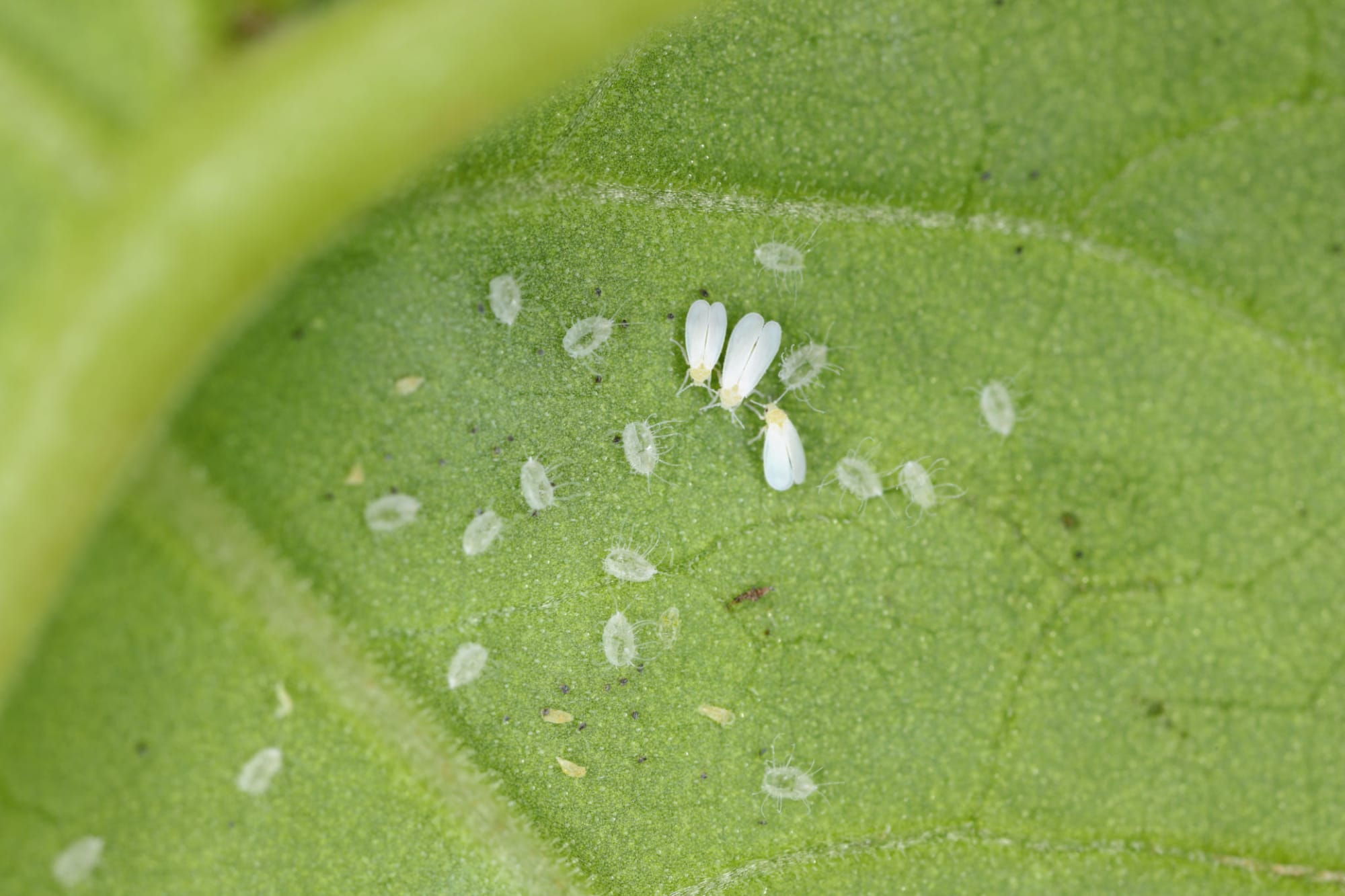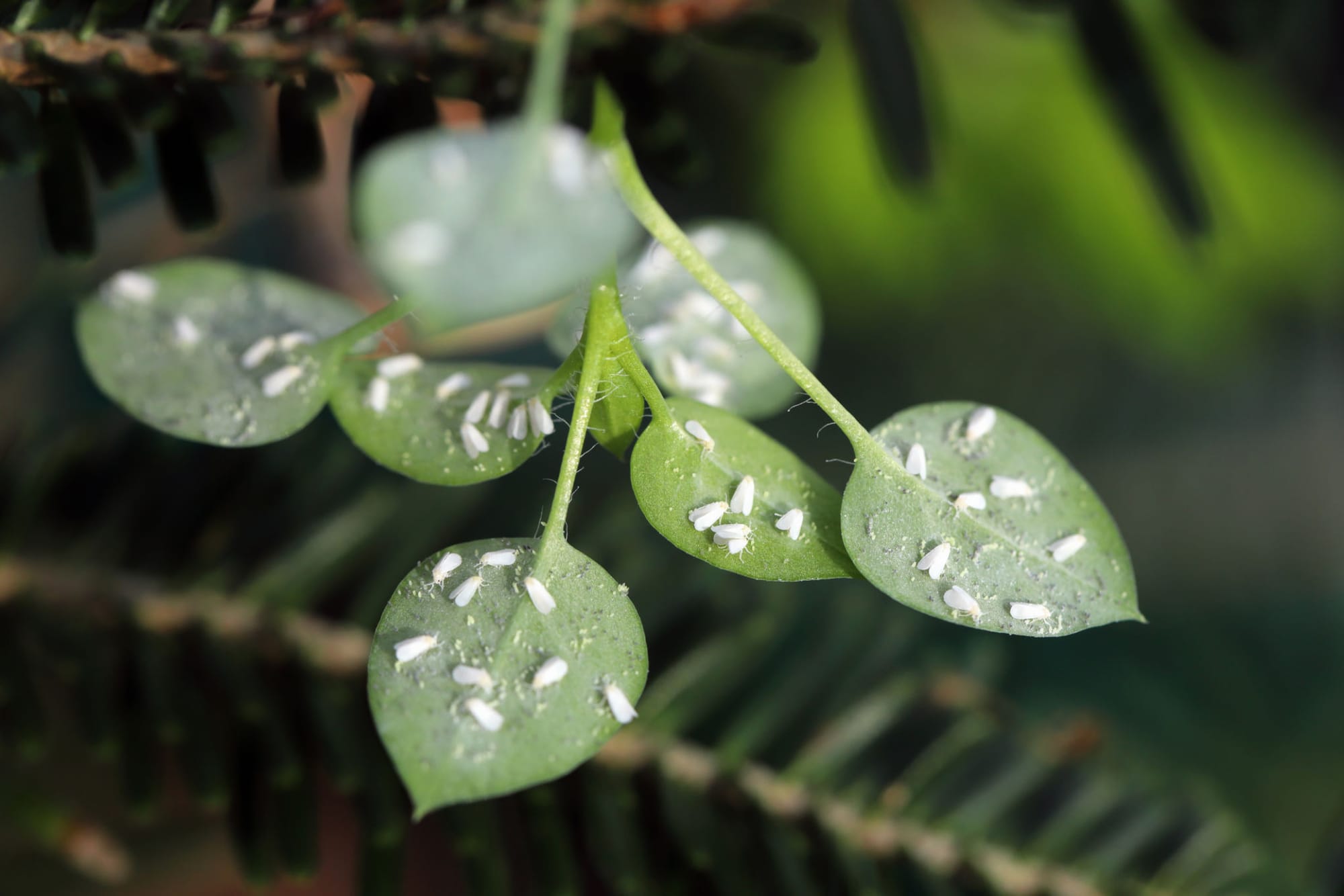Aleyrodidae ssp. Copyright: Gardening Know How
Contents
- Top Tips & Info
- Symptoms
- Susceptible Plants & Parts
- Actions Needed (Includes pros & cons of Chemical or Organic based pesticides)
- Ways to Prevent an Attack in the Future
Need the answer to a specific plant or pest query? Book a 1-to-1 video call with THE HOUSEPLANT DOCTOR™, the website's friendly author, to overcome and address your niggling problem! Available on iMessage, WhatsApp, Facebook Messenger & more.
Top Tips & Info
- Eradication Difficulty - Moderate
- Life Cycle - Up to sixty days.
- The female can lay up to thirty eggs a day - three hundred in total.
- Whitefly will attack all plant parts above the soil, most notably being the foliage and stems (see images below).
- They'll fly around the plant, laying eggs and causing large amounts of damage in the likes of yellowing leaves.
- Remove and crush all of the visible eggs or larvae using your fingers or a damp cloth.
- Prune off the severely affected growths and any flowers that house the infestation. If you can propagate infected plants via water (like Dracaena) - submerge the cutting's entirety for 48hrs to drown the pests - trust us, it works!
- For wooded stems, you can use an old toothbrush to help wipe these areas, if needed.
- Take the plant outside and perform a gentle hose-down. Aim at the cubbyholes for complete obliteration and replace the top inch of the soil to remove any live bugs that have fallen.
- Allow the plant to dry off before applying an organic or chemical-based pesticide THE HOUSEPLANT DOCTOR™ recommends using an organic, predatory mite product like Andermatt's WhiteFly Killer that'll avoid using harsh chemicals.
- Repeat the hosing-down and pesticide steps every 7 - 14 days, for the next month. Quarantine the affected plants to keep the infestation contained, as they are known to spread like wildfire.
Symptoms
Describing the appearance of Whitefly is self-explanatory. Along with the small, angel-like flies hovering around an unfortunate plant, small eggs will be littered over the leaves and stems. Remove the affected plants out of the house and away from other specimens to avoid the problem spreading. Always check neighbouring plants for the infestation, too.
Here's a good example of what Whitefly will look like on a houseplant. They often stay within the underside of the leaves, as the pest can be sensitive to the sunlight,
Another example of Whitefly laying eggs on the underside of a houseplant leaf.
What are the most Susceptible Houseplants & Where do Whitefly live on them?
Infestations will be located in the nooks and crannies of wooded stems, flowers and both sides of the leaves.
Plants - Most specimens can be affected by Whitefly, with most vulnerable being Dracaena, Ficus, Monstera, Palms, Umbrella Trees & Yuccas.
What are the Actions Needed to Eradicate Whitefly from Houseplants?
1. Prepare a room (ideally small) where there aren't any airborne Whitefly or plants present. Providing a 'neutral' zone where you can confidently say that there aren't bugs will strengthen the pest-regulation. Keep the doors shut and regularly check for any critters that may be hovering around the windows or lampshades before the affected plants enter.
2. Cut off the affected areas or flower stalks - if you can't remove them for whatever reason, rub your fingers across the affected areas to destroy the eggs and larvae. Spend some time with this step - the eggs can be housed pretty strongly onto the plant, meaning that the hose may not eradicate all of them.
3. Take the plant outside and GENTLY wash the stem, leaves and each cubbyhole using an outdoor hose. It's important to spray in at least three different angles to ensure thorough administration.
4. While the plant is drying-off, remove the top quarter of the soil in favour of a fresh batch of the appropriate potting-mix - cactus compost for succulents, tropical plants for houseplant compost, etc. This is to remove any fallen larvae of flies that may be hiding in the potting mix.
5. Perform a final hose-down before placing it in a warm room, away from other specimens to dry-off. If the temperature is above 15℃ (59℉), keep it outside so that natural predators, like ladybirds and green lacewings, can have a go at the critters, too.
6. Once the specimen is bone-dry, it's time to administer a pesticide. Although there is a choice between two options (organic or chemical-based sprays), ukhouseplants would highly recommend using the latter option, due to the pest's ability to bypass organic varieties.
(Step 7 follows after the Product Options)
Step 7, Choose Your Product: Organic
Predatory Mites - Releasing Predatory Mites on your affected houseplant's foliage is a more natural approach to controlling the infestation. THE HOUSEPLANT DOCTOR™ recommends using Andermatt's Encarsia WhiteFly Killer that'll get to work within a few hours of being applied to the leaves. We have recently secured a 15% discount for this product with the code 'JOE15' on Andermatt's website.
Insecticidal or Horticultural Soap is another popular organic pesticide on the market, and there are two versions to consider. The first way is by purchasing an RTU (ready-to-use) spray bottle, which can be immediately used on the plants. Although most garden centres will stock this, it's far more economical to purchase the second option - concentrated bottles. This method comes with pro's and con's but is far cheaper to use if you have multiple infestations. It's self-explanatory and highly beneficial for the outbreak as long as you use the correct levels of dilution - the only downside is its availability in local centres. It's best to buy this option online as there are many different companies to choose from, with some being cheaper than others.
Or Choose a Chemical Product
Try using 'Bayer Garden Provado Ultimate Fruit and Vegetable Bug Killer Concentrate', as it worked quickly after one application. It's a concentrated product, meaning that you'll have to dilute it with the appropriate amount of water. Spray both sides of the leaves, along with any cubbyholes that could house the infestation. Repeat this step weekly for the next month to aid the destruction of the pest.
8. Once the pesticide has been administered, locate all of the affected plants into the prepared room. Keep them here for at least a week to check if the infestation continues. Inspect all of the plants along with any windows or lights (Whitefly like light-sources).
9. Open all of the windows in the house (not just the quarantined room) for an hour to allow redundant flies to escape unhurt. It's far easier to let them fly away than attacking each fly individually, as this will take AGES. Get a handheld hoover and suck each airborne pest that you crosses your path, once the windows are shut again. Keep an eye out around the home for the next few days, checking the hard-hit areas of windows and lampshades.
10. After a week of quarantine, inspect the plants for any sign of an infestation. Once there are no more visible pests in the whole house, you can safely re-introduce them back into their original locations. Always keep an eye out for more Whiteflies in the oncoming weeks. Kill or hoover each one that you come across - this can be a long process to eradicate, so doing small hunts each day will make a big difference in the long term!
Extra Tip: Although you should perform the wiping and hosing-down process BEFORE each pesticide application, you can wash the foliage at any given time to keep the infestation under control.
What are the Best Ways to Prevent an Attack in the Future?
1. When buying a new plant from a local plant shop or garden centre, check around the common areas for infestations like its leaves, stems and flowers. Most Whitefly issues come from already-affected plants, so always keep this in mind when increasing your plant-collection!
2. Keep the windows shut during the Spring and Summer months Whiteflies are most active, or set up a magnetic window mesh/netting like these to stop them coming indoors.
3. Change the top layer of the soil when bringing any new plant from a shop. Replacing the top layer of the compost will remove any larvae that may have fallen in, or been deposited by a pest. THE HOUSEPLANT DOCTOR™ does this religiously whenever a new plant enters the house!
4. Perform monthly checks for pests on your own plants. Although this may sound patronising, many gardeners forget to inspect their indoor specimens and that's exactly when an infestation can arise.
Book a 1-to-1 Consultation with THE HOUSEPLANT DOCTOR™
Need realtime advice for your Whitefly situation? Book a video or message consultation with expert Joe Bagley, THE HOUSEPLANT DOCTOR™ (author or ukhouseplants.com). Choose between a ten or thirty-minute session & a platform of your choice (WhatsApp, FaceTime, Facebook Messenger or Zoom). Ask unlimited questions in one session, including queries on your dying/challenging plants, pests eradication, terrariums, repotting advice & everything in between! Available worldwide.

